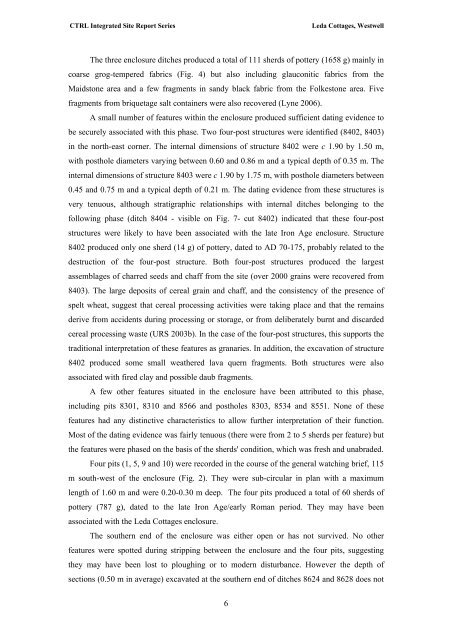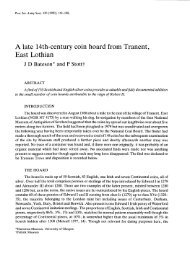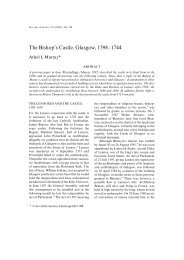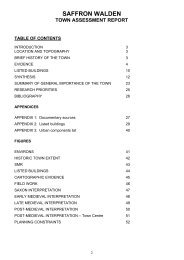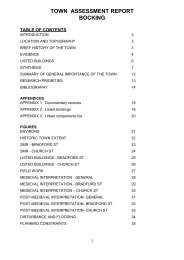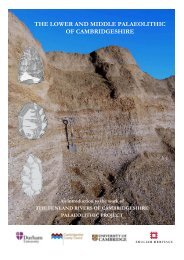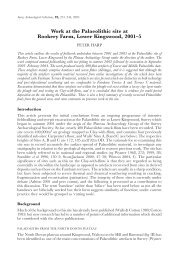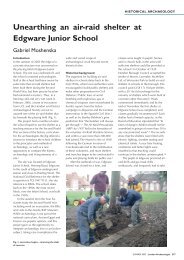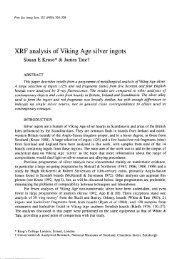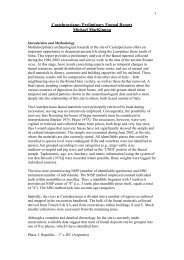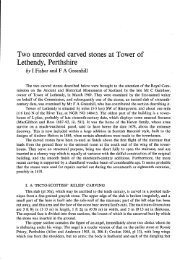The late Iron Age and Roman settlement at Leda Cottages, Westwell ...
The late Iron Age and Roman settlement at Leda Cottages, Westwell ...
The late Iron Age and Roman settlement at Leda Cottages, Westwell ...
You also want an ePaper? Increase the reach of your titles
YUMPU automatically turns print PDFs into web optimized ePapers that Google loves.
CTRL Integr<strong>at</strong>ed Site Report Series <strong>Leda</strong> <strong>Cottages</strong>, <strong>Westwell</strong><br />
<strong>The</strong> three enclosure ditches produced a total of 111 sherds of pottery (1658 g) mainly in<br />
coarse grog-tempered fabrics (Fig. 4) but also including glauconitic fabrics from the<br />
Maidstone area <strong>and</strong> a few fragments in s<strong>and</strong>y black fabric from the Folkestone area. Five<br />
fragments from briquetage salt containers were also recovered (Lyne 2006).<br />
A small number of fe<strong>at</strong>ures within the enclosure produced sufficient d<strong>at</strong>ing evidence to<br />
be securely associ<strong>at</strong>ed with this phase. Two four-post structures were identified (8402, 8403)<br />
in the north-east corner. <strong>The</strong> internal dimensions of structure 8402 were c 1.90 by 1.50 m,<br />
with posthole diameters varying between 0.60 <strong>and</strong> 0.86 m <strong>and</strong> a typical depth of 0.35 m. <strong>The</strong><br />
internal dimensions of structure 8403 were c 1.90 by 1.75 m, with posthole diameters between<br />
0.45 <strong>and</strong> 0.75 m <strong>and</strong> a typical depth of 0.21 m. <strong>The</strong> d<strong>at</strong>ing evidence from these structures is<br />
very tenuous, although str<strong>at</strong>igraphic rel<strong>at</strong>ionships with internal ditches belonging to the<br />
following phase (ditch 8404 - visible on Fig. 7- cut 8402) indic<strong>at</strong>ed th<strong>at</strong> these four-post<br />
structures were likely to have been associ<strong>at</strong>ed with the <strong>l<strong>at</strong>e</strong> <strong>Iron</strong> <strong>Age</strong> enclosure. Structure<br />
8402 produced only one sherd (14 g) of pottery, d<strong>at</strong>ed to AD 70-175, probably re<strong>l<strong>at</strong>e</strong>d to the<br />
destruction of the four-post structure. Both four-post structures produced the largest<br />
assemblages of charred seeds <strong>and</strong> chaff from the site (over 2000 grains were recovered from<br />
8403). <strong>The</strong> large deposits of cereal grain <strong>and</strong> chaff, <strong>and</strong> the consistency of the presence of<br />
spelt whe<strong>at</strong>, suggest th<strong>at</strong> cereal processing activities were taking place <strong>and</strong> th<strong>at</strong> the remains<br />
derive from accidents during processing or storage, or from deliber<strong>at</strong>ely burnt <strong>and</strong> discarded<br />
cereal processing waste (URS 2003b). In the case of the four-post structures, this supports the<br />
traditional interpret<strong>at</strong>ion of these fe<strong>at</strong>ures as granaries. In addition, the excav<strong>at</strong>ion of structure<br />
8402 produced some small we<strong>at</strong>hered lava quern fragments. Both structures were also<br />
associ<strong>at</strong>ed with fired clay <strong>and</strong> possible daub fragments.<br />
A few other fe<strong>at</strong>ures situ<strong>at</strong>ed in the enclosure have been <strong>at</strong>tributed to this phase,<br />
including pits 8301, 8310 <strong>and</strong> 8566 <strong>and</strong> postholes 8303, 8534 <strong>and</strong> 8551. None of these<br />
fe<strong>at</strong>ures had any distinctive characteristics to allow further interpret<strong>at</strong>ion of their function.<br />
Most of the d<strong>at</strong>ing evidence was fairly tenuous (there were from 2 to 5 sherds per fe<strong>at</strong>ure) but<br />
the fe<strong>at</strong>ures were phased on the basis of the sherds' condition, which was fresh <strong>and</strong> unabraded.<br />
Four pits (1, 5, 9 <strong>and</strong> 10) were recorded in the course of the general w<strong>at</strong>ching brief, 115<br />
m south-west of the enclosure (Fig. 2). <strong>The</strong>y were sub-circular in plan with a maximum<br />
length of 1.60 m <strong>and</strong> were 0.20-0.30 m deep. <strong>The</strong> four pits produced a total of 60 sherds of<br />
pottery (787 g), d<strong>at</strong>ed to the <strong>l<strong>at</strong>e</strong> <strong>Iron</strong> <strong>Age</strong>/early <strong>Roman</strong> period. <strong>The</strong>y may have been<br />
associ<strong>at</strong>ed with the <strong>Leda</strong> <strong>Cottages</strong> enclosure.<br />
<strong>The</strong> southern end of the enclosure was either open or has not survived. No other<br />
fe<strong>at</strong>ures were spotted during stripping between the enclosure <strong>and</strong> the four pits, suggesting<br />
they may have been lost to ploughing or to modern disturbance. However the depth of<br />
sections (0.50 m in average) excav<strong>at</strong>ed <strong>at</strong> the southern end of ditches 8624 <strong>and</strong> 8628 does not<br />
6


